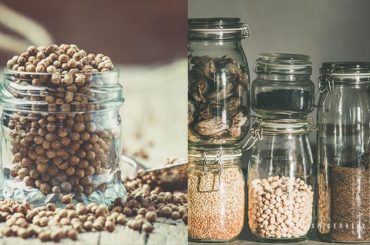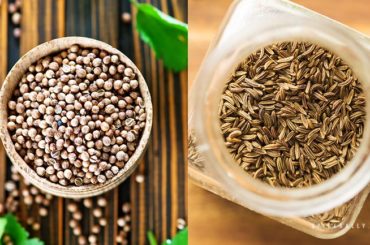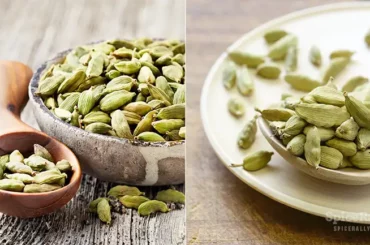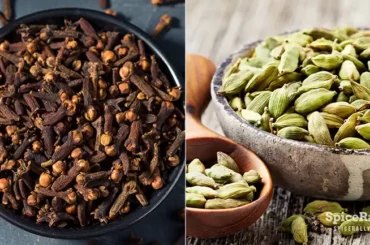Predominantly used in Asian cuisine, turmeric and ginger are two outstanding spices that offer their flavor and nutrition to many delicious dishes. So, in this article, let’s see what you need to learn about turmeric vs ginger.
The key difference comes down to the color of the two spices. Turmeric is considered a colorant spice with a vibrant yellow hue, while ginger is light brown on the outside and pale yellow inside.
In addition, turmeric has a fine earthiness with peppery and bitter notes, whereas ginger is warmly spicy and pungent with a slightly sweet note. Both of them have different health benefits and uses in cooking.
So, read further to clarify your doubts about these two pantry staples.

Turmeric vs Ginger
| Turmeric | Ginger | |
|---|---|---|
| Flavor profile | Less pungent than ginger with an extremely earthy note. It is also warm and woodsy with a bitter and peppery bite. | Fresh ginger is more pungent than turmeric with warmly spicy, sweet, citrusy, and a slight floral hint. Dried, ground ginger is less intense than fresh ginger. |
| Aroma Profile | The fragrance profile is not yet determined. But it is musky and mildly scented with hints of orange or ginger. | Warm, spicy, woody, and earthy with a slight citrus note. |
| Forms | – Dried rhizomes – As fresh rhizomes – Ground – Powdered – Pills/ capsules – Paste – As teas – As an essential oil | – Dried rhizomes – As fresh rhizomes – Ground – Powdered – Granulated – Pills/ capsules – Pickled – Preserved – Paste – As teas – As an essential oil |
| Availability | Widely available in grocery stores, supermarkets, Asian grocery stores, and online shopping sites. | Widely available in grocery stores, supermarkets, Asian grocery stores, and online shopping sites. |
| Purpose in cooking | As an ingredient | As an ingredient |
| Usage in cooking | – Mainly used in Asian-inspired curries. – Powdered turmeric is one of the main ingredients in many seasoning and spice blends. – Fresh turmeric rhizome is often used in making turmeric tea, golden milk, smoothies, and latte. – Turmeric powder is incorporated into soups, broths, stews, and stir-fries. – Asians often used this spice in making desserts, sweetmeat, and baked food. – In making savory rice dishes, noodles, pasta, and spaghetti To be incorporated into sauces, dips, and other condiments like yellow mustard. – In marinades, wet rubs and dry rubs are made to season meat and fish. Read more – 10 Best Practical Ways To Use Turmeric | – Ground/powdered ginger features many spice blends and seasoning mixtures. – Fresh ginger is incorporated into soups, stews, broths, and stir-fries. – Pickled ginger is used as a condiment in Asian cuisine. – Preserved ginger is used in making cakes and puddings. – Sri Lankans popularly use fresh ginger by infusing it with black tea. – Used to make juices and smoothies. – An integral ingredient in many marinades and wet rubs. – Ginger-garlic paste is used as the base for many Asian curries. Read more – I added Ginger to 70% of my cooking. Here’s what I found! |
| General use | – In cooking and baking – Is an effective ingredient in modern and herbal medicine (Ayurveda and home remedies) Current cosmetology and perfumery use this spice in making beauty products like soaps, creams, lotions, scrubs, etc. – Some Asian communities include turmeric as a definitive ingredient for many of their religious and auspicious events. – It is commonly used in DIY beauty hacks like face masks and scrubs. | – In cooking and baking – Used in many home remedies as a traditional medicine – Modern pharmacology uses ginger in medication. – Is used in Ayurveda |
| Health benefits | – Helps in reducing inflammation in the body – Encourages skin health – Promotes cardiovascular health – Supports in managing and inhibiting diabetes – Rich in antioxidants – Helps in oral-related conditions – Has anti-carcinogenic properties – Protects the liver – Helps to soothe the symptoms of osteoarthritis – Aids in controlling eye degeneration Read more – 10 Proven Health Benefits Of Turmeric | – Treats morning sickness and nausea – Might help with obesity and promotes weight loss. – Relieves the symptoms of osteoarthritis – Contains anti-diabetic properties – Improves heart disease factors – Helps in treating chronic indigestion – Significantly reduces menstrual pain – Might help lower bad cholesterol levels – Has anti-cancer properties – Improves brain function |
| Main featuring cuisines | Indian, Thai, Middle Eastern, and Sri Lankan cuisines | Indian, Korean, Thai, Western, Chinese, Japanese, and Vietnamese cuisines. |
| Appearance | A fleshy rhizome that is bright yellow in color and turns to a yellowish-golden powder when pulverized. | Light, grayish-brown on the outside and pale yellow inside. It is a juicy rhizome that will turn to a pale brown powder when ground. |
| Scientific name | Curcuma longa | Zingiber officinale |
| Plant family | Zingiberaceae | Zingiberaceae |
| Active compounds | Curcuminoids/ curcumin | Gingerol, shogaols, and paradols |
| Origin | Southern India and Indonesia | Southeast Asia |
| Shelf life | – Ground/powdered turmeric can stay up to 3-4 years when stored in a tightly-fitting glass jar/container in a dry, dark, cool place. – Fresh turmeric can stay well for about 6-9 months in the freezer | – Fresh, unpeeled ginger can stay fresh in the refrigerator for about a month when stored properly. – When stored in a glass air-tight container/jar, ground/powdered ginger will stay at its best quality for about 3-4 years. |
More Insights Into The Difference Between Turmeric And Ginger…
Actually speaking, the looks of these two spices can be absolutely slippery since they look so much similar. But, as you got yourselves cleared through the table above, turmeric and ginger have significant differences in terms of their flavors, colors, properties, health benefits, etc.
We can find many instances where turmeric and ginger are used together. For example, ginger is usually used when making turmeric tea, ginger-turmeric lemonade, and even in certain rice dishes. But most often, turmeric is primarily used for its strong colorant effect and ginger for its pungent flavor and warm aroma.
However, these spices have been used since ancient times as traditional medicines thanks to their incredible health benefits. Therefore, none is superior to the other in terms of nutrition. In fact, both are rich in antioxidants and help to fight against many ailments.
Nevertheless, due to their distinctive flavor profiles, substituting for each other is not recommended, even though they belong to the same plant family or look similar. Above all, you will not get the bright yellow color that turmeric typically gives by using ginger in place of turmeric. And turmeric will not provide the zest of ginger if substituted.




